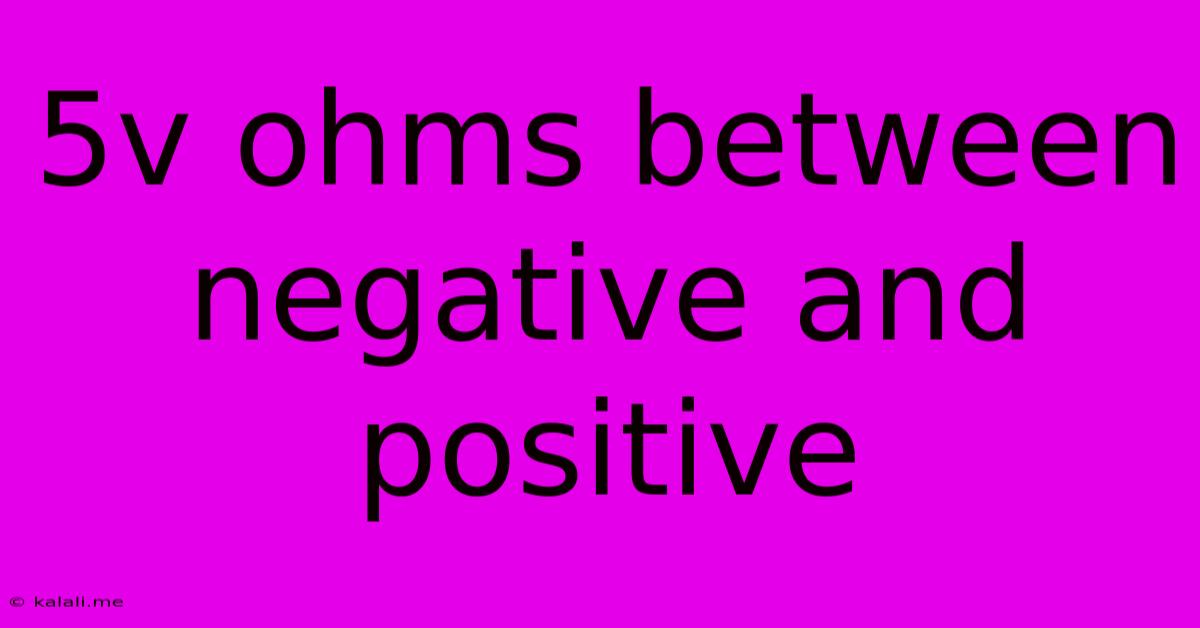5v Ohms Between Negative And Positive
Kalali
Jun 03, 2025 · 3 min read

Table of Contents
Decoding the Mystery: Understanding 5V and Ohms Between Positive and Negative
This article delves into the often-misunderstood relationship between voltage (5V), resistance (ohms), and the connection between positive and negative terminals in an electrical circuit. We'll break down the basics and explore what a 5V potential difference across a certain resistance means in practical terms. Understanding this fundamental concept is crucial for anyone working with electronics, from hobbyists to engineers.
What Does 5V Mean?
5V, or 5 volts, represents the electrical potential difference between two points in a circuit. Think of it as the "pressure" pushing electrons through the circuit. A higher voltage means a greater pressure, resulting in a stronger current flow (if the resistance remains constant). 5V is a common voltage used in many electronic devices, including USB ports, microcontrollers, and sensors.
What are Ohms?
Ohms (Ω) represent electrical resistance. Resistance is the opposition to the flow of current. A higher resistance means a smaller current will flow for a given voltage. This resistance is inherent in all materials, with some materials (like conductors) offering very low resistance and others (like insulators) offering very high resistance. Resistors are components specifically designed to provide a precise amount of resistance in a circuit.
5V across a Resistance: Ohm's Law
The relationship between voltage (V), current (I), and resistance (R) is defined by Ohm's Law: V = I * R. This means that the voltage across a resistor is equal to the current flowing through it multiplied by its resistance.
Let's consider a few scenarios involving 5V and different resistances:
-
Scenario 1: 100Ω Resistor: If you have a 5V source connected across a 100Ω resistor, the current (I) can be calculated using Ohm's Law:
I = V / R = 5V / 100Ω = 0.05Aor 50mA. This is a relatively small current. -
Scenario 2: 10Ω Resistor: With a 10Ω resistor and a 5V source, the current is much higher:
I = 5V / 10Ω = 0.5Aor 500mA. This higher current could potentially overheat the resistor if it's not rated for that current. -
Scenario 3: Short Circuit: A short circuit occurs when there is essentially zero resistance (0Ω) between the positive and negative terminals. This results in a very high current, potentially damaging the power source or causing a fire. This is why short circuits are extremely dangerous.
Practical Implications and Considerations
Understanding the interplay between voltage, resistance, and current is critical for designing and troubleshooting circuits. Incorrectly selecting components can lead to:
- Overheating: Too much current flowing through a resistor can cause it to overheat and fail.
- Component Damage: High currents can damage sensitive electronic components.
- Power Supply Failure: Excessive current draw can overload and damage the power supply.
Always carefully calculate the current flowing through a circuit using Ohm's Law to ensure that components are appropriately sized and rated for the expected current. Choosing the correct resistor value is essential for ensuring the proper operation and longevity of your electronic projects. Consider using resistor color codes or online calculators to determine the resistance value accurately.
This understanding of 5V and ohms, along with a grasp of Ohm's Law, provides a foundational knowledge for anyone venturing into the world of electronics. Remember safety is paramount; always handle electronics responsibly and carefully plan your circuits.
Latest Posts
Latest Posts
-
Is Blue Christianity Life Of Pi
Jun 05, 2025
-
Cake Mix Expired 2 Years Ago
Jun 05, 2025
-
How To Forward Gmail To Another Email
Jun 05, 2025
-
Apply Hash Lines To Image In Illustrator
Jun 05, 2025
-
History Teaches Never Trust A Cecil
Jun 05, 2025
Related Post
Thank you for visiting our website which covers about 5v Ohms Between Negative And Positive . We hope the information provided has been useful to you. Feel free to contact us if you have any questions or need further assistance. See you next time and don't miss to bookmark.